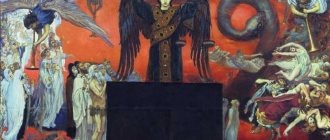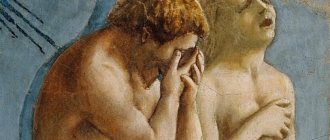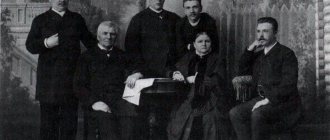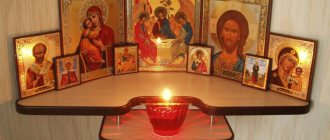Description of the painting “Nestor the Chronicler” by Viktor Vasnetsov
V. Vasnetsov, “Nestor the Chronicler”, 1885-1896, Photo: muzei-mira.com
| Name | Nestor the Chronicler |
| Country, artist | Russia, Viktor Mikhailovich Vasnetsov |
| Year | 1885-1896 |
| Genre | romanticism, christian art |
| Located | State Tretyakov Gallery, Moscow |
| Materials | cardboard, watercolor |
The painting “Nestor the Chronicler” was painted by the Russian artist Viktor Vasnetsov in 1885-1896, during his stay in Kyiv, where he was invited to paint the Vladimir Cathedral.
Worthy to be canonized
The main character of the canvas - the creator of the first Russian chronicle “The Tale of Bygone Years” - Nestor is depicted as a gray-haired old man, poring over his legendary work. In his sinewy hand there is a completely fresh, unworn pen, although in the book lying in front of him, entries that have just been made are visible. Thinking about something, he looks up from his work for a moment.
The chronicler's face, despite his advanced age, is not at all senile - instead of the burden of years, it is decorated only with marks of experience and wisdom, which is why it seems both strict and kind.
Nestor is leaning on a massive wooden music stand - a book stand made in the traditional Russian style. On it are the attributes of the writer's craft - a pile of parchment scrolls, quills and an inkwell.
Vasnetsov depicted the interior of the room in the spirit of the ideas of the intelligentsia of his time about ancient Russian architecture - this is, first of all, massive and roughly made wooden furniture, a tiled floor and bare plastered walls, a fancy arched window in which the domes of Vladimir Cathedral and other buildings are visible.
The hero’s attire deserves special attention – a cassock and a dark cloak with a hood. The use of a rich palette creates the feeling that the picture has just been painted and the paints are still drying, and contrasting and clear transitions between objects focus the viewer’s attention on the personality of the chronicler.
Vasnetsov pays tribute to the hero of his canvas, depicting him in a humble, but at the same time, majestic pose of a man carrying fundamental knowledge. Indeed, Nestor’s work “The Tale of Bygone Years” became the earliest ancient Russian chronicle that has survived to this day, which has allowed modern man to learn a lot about the affairs of bygone days. Another evidence of the respect shown to the chronicler is the presence of a halo above his head. By this, Vasnetsov shows that he considers it worthy to see the elder among the saints.
Prayers
Troparion, tone 4
The great princes of the Russians, the deeds/ and the venerable Father of Pechersk, who wrote the lives and miracles,/ but his own, to the God-Wise Nestor, of many, for the sake of virtues, the name/ was written in heaven, acquisitive,// they say and we too should write in the Book of Animals.
Troparion, tone 4
Times and years of memorable deeds,/ exploits and labors of the God-bearing fathers,/ writing to Nestore the Wise,/ you were kindled with love to follow in the footsteps of the first ones,/ with him do not cease to pray X I pray to God that our souls may be saved.
Kontakion, tone 2
As this God-bearing Theodosius is a disciple / and a true imitator of his life, / the first self-witness of his honest relics, you were honored to be, / who, with others, scrupulously carried, / inherited you with the same Kingdom of Heaven, / which we, who honor you, may also receive from the Lord.
Biography of Theodosius of Pechersk
In the 1080s, another famous work was created, the author of which was Nestor the Chronicler. The description of the life of St. Theodosius of Pechersk is a most valuable source of information about the fate of this extraordinary Orthodox holy ascetic. This is an outstanding work of ancient Russian writing. Speaking about the composition and content of the biography, it should be noted that it was written strictly according to the then existing canons, but at the same time it had undeniable artistic value.
The work shows the fate of Theodosius of Pechersk from birth to his death. As was customary, Nestor the Chronicler glorifies in it the Christian humility, obedience and fortitude of the venerable elder. The image of Theodosius embodies true mercy, compassion and love for people. In addition to the biography itself, the work also describes the life of the early period of the existence of the Kiev-Pechersk monastery.
Let us add that in 1091 Nestor was given a special commission to find and dig up the holy relics of St. Theodosius of Pechersk from the ground, in order to subsequently transfer them to the temple. According to his story, he and two other monks, while performing this honorable and responsible task, turned out to be eyewitnesses of extraordinary miracles.
Successors
Dying, the elder bequeathed the development of his grandiose story to other monks of the Kiev-Pechersk Monastery. His followers were Abbot Sylvester, who designed The Tale of Bygone Years in its modern form, and Abbot Moisei Vydubitsky, who continued it until the thirteenth century. And, in addition, Abbot Lavrenty. This chronicler in 1377 created the so-called “Laurentian Chronicle” - the most ancient of the lists that have survived to this day, preserving the “Tale”, on which the reverend Pechersk ascetic Nestor the Chronicler worked. A photo of this priceless relic is available to everyone, and it itself is stored in the Russian National Library in St. Petersburg. The heir to the hagiographical tradition of Nestor was Simon, Bishop of Vladimir.
see also
- Painting by Vasnetsov button accordion essay
- Painting bayan vasnetsova essay
- Bayan painting by Vasnetsov essay
- Vasnetsov Koschey the immortal painting
- Vasnetsov painting Koschey the immortal
- Airplane carpet painting by Vasnetsov
- Painting carpet plane Vasnetsova
- Painting by Vasnetsov carpet plane
- Painting by Vasnetsova Sivka Burka
- Essay based on a painting by Vasnetsov
- Painting of the Frog Princess Vasnetsova
Examples of similar educational works
Based on the painting The Sleeping Princess Vasnetsova description
... the good prince will save her. Description of the mood of the painting The Tale of the Sleeping Princess Popular topics today The artist’s parents were very... they were often invited to the fun. The princess herself froze in the center of the picture. And from her silhouette we can say that everything...
The history of the creation of a portrait of a Chelishchev boy. “Portrait of a boy Chelishchev”, Orest Adamovich...
... write an essay based on the painting Portrait of a boy Chelishchev Kiprensky The portrait of the famous artist Orest Adamovich Kiprensky depicts a twelve-year-old boy - Alexander Chelishchev, a future cadet of the Corps of Pages, later a hero of the War of 1812 and ...
Describe nature in spring. Description of nature in spring. Essays by topic
... living beauty. Category: Essays on a free topic In spring, the forest comes to life after a long winter. Until recently it was gloomy, and the trees stood bare. But now the forest was illuminated by the spring sun. ...
Description of the animal in the essay “My Pet”
… next to them. Any pet brings a lot of positive emotions to a person. Although sometimes animals can be harmful, they are... with their beloved cat. Unusual habits habits, unusual for families of the cat class: she loves to swim; eats cucumbers; Not …
Essay on the topic: THE GREAT CHRNICALER NESTOR
THE GREAT CHRONICLE NESTOR
The earliest ancient Russian works were chronicles, in which events were recorded by year, or, as they said in the old days, by year. Over the course of seven centuries, from the 11th to the 17th centuries, Russian chronicles were created.
The first history of Ancient Rus' - a chronicle called “The Tale of Bygone Years” was compiled by the monk of the Kiev-Pechersk Monastery Nestor. In the title of his great work, he wrote: “This is the Tale of Bygone Years, where the Russian land came from, who began the reign in Kyiv and where the Russian land came from.”
The chronicler describes in detail not only the history of the Slavic tribes, but also connects it with the history of all mankind. He describes the events of bygone days and his time, glorifies Prince Vladimir, who introduced Christianity to Rus', thereby opening the way for the state to cultural development and exchange with other peoples. Nestor highly appreciates the merits of Yaroslav the Wise, who did a lot for the enlightenment of Rus'.
He worked hard to clarify the chronology, starting the narrative from 852, since under this year he found the first mention of Rus' in the Byzantine chronicle. However, Nestor did not consider this year the “beginning” of the Russian state. The story in the form as Nestor wrote it has not reached us.
The chronicler constantly reminds of the morality of actions, of respect for fatherly traditions and customs. From the first stories (“Olga’s Revenge”, “On the Murder of Boris and Gleb”, “Belgorod Kisel”, “The Blinding of Vasilko”) to the last, the idea is affirmed that evil is punishable.
Searched on this page:
- essay based on Vasnetsov's painting Nestor the Chronicler
- description of Vasnetsov's painting Nestor the Chronicler
- essays for 6th grade
- description of Vasnetsov's painting Nestor the Chronicler
- description of the painting Nestor the Chronicler
vsesochineniya.ru
V. Vasnetsov. Nestor the Chronicler.docx - Course of lectures. History of paintings. IN. …
Vasnetsova. Nestor, monk of the Kiev Pechersk Monastery (about 1056-1114), spiritual writer, thinker, chronicler, author of The Tale of Bygone Years. From the “Life of Theodosius of Pechersk” written by Nestor, we learn that he was tonsured under Abbot Stefan (whose years of abbotship were 1074-1078) and elevated by him to the “deacon rank” and that even before the “Life of Theodosius” he wrote “Reading about Boris and Glebe." “Reading about the life and destruction of the blessed passion of Boris and Gleb” was written by Nestor according to the canon of the life of the martyr. Nestor prefaces the stories of the death of the sons of Vladimir Svyatoslavich with an extensive historical introduction, in which he reflects on the eternal struggle between good and evil. According to Nestor, Russian history is a struggle between good and evil, the eternal good principles of the human soul with the demonic temptation of the forces of evil. Boris and Gleb appear in “Reading” as active champions of Christian ideals - humility and brotherly love, and Svyatopolk appears as an instrument of the devil’s machinations. “Reading” is inferior in popularity and prevalence to the anonymous “The Tale of Boris and Gleb.” After the “Reading,” Nestor writes “The Life of our Venerable Father Theodosius, Abbot of Pechersk,” which tells about the life and deeds of one of the founders of the monastery. As is typical for the lives of the righteous who labor in the monastery, the “Life of Theodosius” is distinguished by the vividness of its characteristics of monks and laity. Nestor achieves the illusion of verisimilitude in the description of the miracles performed by Theodosius, skillfully depicting everyday details, naturally conveying the dialogues of the characters. The image of Theodosius’s mother especially stands out in the “Life”: contrary to tradition, Nestor does not depict a pious Christian woman devoid of any individual traits, appearing in the conventional role of the mother of a saint, but, on the contrary, depicts a powerful, stern woman, resolutely opposed to the religious aspirations of her son, who does not stop before in order to brutally beat or put on a chain a youth who dreams only of godly deeds and tonsure. The hagiographic image of Theodosius himself is complex and, perhaps, close to its prototype: distinguished by extraordinary humility in monastic life, Theodosius nevertheless sharply condemns Prince Svyatoslav for unseemly actions . Researchers have found plot motifs in the Lives that seem to have been borrowed from translated Byzantine Lives, but, probably, we should only talk about the similarity of the situations: Nestor always fills the story with specific features of Kyiv life and monastic life of the 11th century. In this regard, the following episode is interesting: the prince, who was somewhere outside the city, instructs a certain youth to take Theodosius in a cart to Kyiv. Seeing the shabbyly dressed Theodosius, the young man takes him for a simple monk and, condescendingly reproaching him for his constant idleness, offers to change places: the young man will sleep in the cart, and let Theodosius drive the horse. True to his customs, Theodosius humbly agrees. But when the travelers approached Kyiv, the young man notices the extraordinary respect shown to Theodosius, and with fear he realizes his mistake. In this episode, in addition to a purely moralizing idea - glorifying the humility of Theodosius -
znanio.ru









